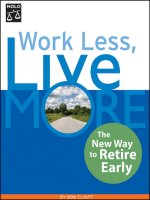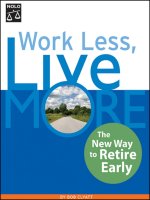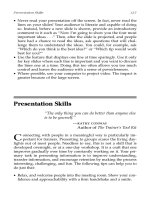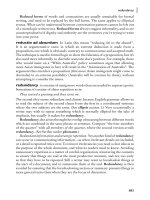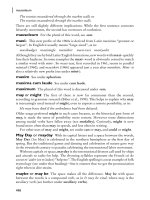the nordstrom way to Customer Service Excellence phần 7 pps
Bạn đang xem bản rút gọn của tài liệu. Xem và tải ngay bản đầy đủ của tài liệu tại đây (159.26 KB, 28 trang )
Dump the Rules
151
You’re a paying customer, right there on the property, yet the
person on the phone is getting all the attention.”
Mike’s, like Nordstrom, has a handbook that serves as a
guide to things like benefits, as well as policies prohibiting
stealing,smokingontheproperty,andsoon,butwhenit
comes to customer service, Mike’s, again like Nordstrom, likes
to keep it simple.
“The biggest thing we tell them to do is to exceed customers’
expectations without slowing the operation down,” said Dahm.
“When someone gets his car egged, that stuff does not come off
with a car wash. You have to use some compound and some wax
to remove it. It wouldn’t be uncommon for one of my associates
to say to the customer, ‘We’re not too busy. Pull your car over
here and let me clean it off for you.’ ”
Terri Breining, founder and president of Concepts World-
wide, a meeting planning company, said that the contracts that
Concepts Worldwide enters into with clients spell out the guide-
lines of exactly what the firm will do for the customer on a par-
ticular project.
But beyond the basic guideline, project managers are unen-
cumbered with a lot of rules and are allowed “to do the job what-
ever way they want to,” said Breining. “Each of our meeting
planners has a different style of doing those things.” Because of the
individual styles of the project managers, clients can choose the
manager they want to work with. “We’ve had experiences where
a client and one of our meeting planners didn’t get along. We don’t
have a rule that the client has to work with that particular planner.”
Obviously, Concepts Worldwide, like every other business,
needs to be profitable, and “We expect our project managers
to make sure that their projects are brought in within budget,
and that the clients are happy,” said Breining. “But within those
WHAT SUPERVISORS CAN DO
152
pa
rameters, they are relatively free to do whatever they have to
do—as long as it’s not illegal or immoral.”
Tom Limberg, general manager of the W Hotel in Seattle,
said that “Good service is not about an employee with his head
down looking in the three-ring binder rule of rules. We don’t
live in a world of black and white; we live in a world of gray,
where we bend rules to fit customers. We don’t bend customers
to fit rules. That’s what empowerment is.”
FirstMerit: Decide on What’s Best for the Customer.
When John Cochran first arrived at FirstMerit Bancorp in 1995,
he found an organization that was “very operationally oriented,”
he recalled. “It wasn’t a marketing organization, which is what
we are today. FirstMerit had all sorts of clearly stated procedures
that were quite severe and radically customer unfriendly, and
there were severe penalties for not following those procedures.”
Ever since he assumed the position of chairman and chief
executive of FirstMerit, Cochran has tried to eliminate as many
rules as possible and to create a company that is “like Nord-
strom, where employees are encouraged to use their common
sense,” he said.
Over the years, St. Charles Medical Center in Bend, Ore-
gon, has made wholesale changes in its process simply by exam-
ining every policy and procedure—including the historic reason
why a policy or procedure was implemented in the first place.
“For example,” said chairman emeritus Jim Lussier, “quite
often, we found that seven years ago something happened in
the emergency room that had never happened before, and the
emergency room supervisor at that time said, ‘We need a pol-
icy about that.’ So, somebody wrote a policy specifically about
Dump the Rules
153
that par
ticular incident. Years later, although that type of situa-
tion never occurred again, the policy was still on the books.”
Therefore, St. Charles set about changing the mind-set and
philosophy of procedures by empowering its caregivers. “We
changed things by telling people: ‘You’re in charge of the situa-
tion. If you guys can stay within these fencelines and use the val-
ues of St. Charles, then you make the decisions you need to
make. We’ll support you every time. You don’t need to look into
a policy and procedure book about how to do that. Use your best
judgment,’ ” said Lussier.
By trusting people to use their best judgment and telling them
not be dictated by strict policies and procedures, St. Charles has
found that “People are willing to crawl out on limbs and make
decisions and muddle through a situation that is sometimes life-
threatening,” said Lussier.
In the process, the folks at St. Charles discovered an amazing
thing. “We found that the quality people—the good, assertive
folk that we have always relied on—weren’t using all those poli-
cies and procedures anyhow,” said Lussier with a smile. “In their
own minds, they had already dumped the rules and were natu-
rally using their best judgment. We were fooling ourselves that
we had that kind of control.”
Keys to Success
Ⅲ Trust the judgment of your frontline workers. If you don’t
trust them, why did you hire them?
Re-examine every rule and regulation in your organization.
Let each rule stand or fall on its own merits. Do those rules and
(Continued)
WHAT SUPERVISORS CAN DO
154
(Continued)
regulations make sense in today’s business environment? If not,
dump them!
Ⅲ Simplify the procedure that your employees take in taking
care of the customer.
Ⅲ Do what’s right for the customer—and right for the company.
Ⅲ When in doubt, do what Continental Airlines did: Burn
your rulebook!
Ⅲ Promote one main rule: The Golden Rule.
EXERCISE
Examine Your Rules
Ⅲ Bring out your rulebooks, employee manuals, procedures,
and so on.
Ⅲ Assign a group of people to review all these materials.
Ⅲ Ask them to write down all the rules, procedures, and so on
that are internal—that is, not mandated by outside legisla-
tion, regulation.
Ⅲ Compile that list and distribute it to all the people in your
organization.
Ⅲ Have people in your organization vote on those lists: What
rules belong? What rules need to be eliminated?
Ⅲ Eliminate all the rules that come between you and your
customer.
155
This Is How We Do It
Manage, Mentor, and
Maintain Great Employees
I hear and I forget. I see and I remember. I do and I understand.
—Chinese Proverb
8
157
A
s we explained in Chapter 5, Nordstrom wants to hire
men and women who are already nice and already moti-
vated before they come to work for the company.
Nordstrom provides very little in the way of a formalized
training program. And when asked who really trains his sales-
people, chairman Bruce Nordstrom replied, “Their parents.”
Once Nordstrom salespeople have gone through employee
orientation and have become familiar with the culture, the sys-
tems, the merchandise, and the sales goals expectations, they are
encouraged and empowered to f ind their own way of doing busi-
ness. This book is entitled The Nordstrom Way, but there are ac-
tually some 50,000 Nordstrom ways, because each employee is an
individual, with an individual style and approach to taking care
of the customer.
Like competitive athletes, Nordstrom salespeople are moti-
vated in a variety of ways to give extraordinary service because
extraordinary service produces extraordinary sales volumes. The
company regularly distributes videotaped interviews with top
salespeople who offer tips and advice. Frequent staff meetings are
used as workshops for salespeople to compare, examine, and dis-
cuss sales techniques, and to perform skits in which they play the
roles of salesperson and customer. Top salespeople frequently talk
to their colleagues about goal setting, marketing, selling, using
the phone, and, of course, customer service.
WHAT SUPERVISORS CAN DO
158
The Importance of Mentors.
It is up to managers and buyers to bring out the best in each of
those employees. How is that done? Like everything else at Nord-
strom, it starts with the initiative of each individual. Nordstrom
has found that to achieve the top levels of sales performance,
salespeople must have the requisite patience to gradually, over
time, develop a personal clientele. They can build up their busi-
ness by using the sales tools made available by Nordstrom—most
important—by learning from other successful salespeople.
In other words, they are asked to find a mentor. They are en-
couraged to find a successful Nordstrom salesperson and watch
how he or she does business. You can borrow the styles of sev-
eral people and then take those ingredients create your own style.
Again, that requires time and patience.
While new salespeople are encouraged to f ind mentors who
have created and perfected their own sales tips and techniques,
those new people are also encouraged to f ind their own niche,
their own way of taking care of business because, ultimately, suc-
cess at Nordstrom comes down to what works for each individual.
“Mentors are everywhere,” say many top Nordstrom sales-
people. Management encourages its top sales performers to men-
tor new salespeople.
As he was winding down his career at Nordstrom, “being num-
beronewasnotasimportanttomeasitusedtobe,”saidDavid
Butler, a now-retired, top-performing shoe salesman from the
Tacoma store. “It would have been very selfish of me not to share
with other people what I was able to accomplish. I tried to help
teachotherswhatittakestobecomeaPacesetterandgivethem
the tools to do it. It was a lot more fun for me helping the entire
department make their day, which helped the store make its day.”
This Is How We Do It
159
As we discussed previously, the Nordstrom culture is an es-
sential part of what sets this company apart from all others. Those
successful salespeople like David Butler, those mentors, embody
that culture and transfer that culture to new Nordstrom associ-
ates. That’s how this company has been able to thrive for more
than a century, through four generations of management.
Find a Mentor.
“You can observe a lot just by watching,” Yogi Berra once said.
That’s why Nordstrom encourages new hires to keep their eyes
open when searching for a mentor.
Leslie Martin, manager of the Fashion Valley store in San
Diego, encourages new employees to “watch, observe, ask ques-
tions. That’s part of empowerment. People will eventually de-
velop their own style.”
When Denise Barzcak started in sales at the Town Center
mall store in Boca Raton, she found that the best training came
from watching salespeople who were already successful. “We saw
how they were so consistent. They were leading by example. You
wanted to follow along, to be as good as they were because you
were in the same situation. That core group motivated us
throughout the training.”
Leslie Umagat, a salesperson in the downtown Seattle flagship
store, believed that the best employee training was informal,
learning from the veteran salespeople on the department team
and observing how they made their business happen.
Early in her career, “I worked with five Pacesetters at one
time,” she recalled. “It was difficult, and it was challenging. I
was just starting. I had to find out what was my style and what
WHAT SUPERVISORS CAN DO
160
would make my business happen. You can extract the things that
work for you.”
She learned quickly that a loyal customer always goes back to
the same salesperson. In a department of five Pacesetters, each
Pacesetter had her own loyal coterie of customers.
“I recognized which customers were loyal to which sales-
people,” said Leslie. “I built my base by keeping an open mind.
When someone else’s personal customer walked into the depart-
ment, but that salesperson was not on the f loor, I would say to
myself, ‘Yes, that’s her personal customer, but how can I help
that customer today?’ I wanted to give the best service I could
give on a consistent basis. I built my customer base on keeping
my promises.”
When Patrick McCarthy joined Nordstrom in 1971, he soon
realized that he needed a mentor to teach him how to survive at
Nordstrom. He eventually found his role model in a coworker
named Ray Black, who was a professional men’s wear salesman.
Thoroughly knowledgeable about the merchandise, Black could
take a swatch from a bolt of fabric that was going to be tailored
for a suit and coordinate a complete wardrobe of shirts and ties,
all the way down to the cufflinks.
Before joining Nordstrom, Black had worked for many years
in several of downtown Seattle’s fine specialty men’s wear shops,
and his loyal clients followed him from store to store. “They
came into the department asking for Ray because he identif ied
their needs and knew how to satisfy them,” McCarthy recalled.
“Men saw him as an ally. They heeded his advice on where to get
a good haircut or what style of glasses to wear. He offered them
choices and suggestions and gave them the confidence to try
something different. Their wives saw Ray as the mediator who
could interpret their views to their husbands.”
This Is How We Do It
161
McCarthy also noticed that Black had the ability to not only
remember a customer’s name, but his last purchase as well. (This
was long before previous purchases became part of the store’s
computerized database.)
“I thought to myself, ‘I want to be able to do that.’ ” So, Mc-
Carthy volunteered to help Black whenever and wherever Black
needed him, and the veteran salesman accepted the offer. “Pretty
soon, we developed a routine: After Ray sold suits and sport coats
to his customers, I helped them with their shirts and ties. With
that increased customer contact. I was able to develop my poise
and improve my interviewing skills.”
Most important, Black taught McCarthy how to become an
entrepreneur who could create his own business.
Black didn’t sit around waiting for people to walk into the
men’s wear department; he was calling customers on the phone to
alert them to new merchandise that was arriving in the store.
“Ray showed me what a good salesman should be; he showed me
that the Nordstrom system worked and that I could make as much
money as I wanted,” McCarthy recalled. “The way I saw it, the
Nordstroms were taking all of the risks and providing all of the
ingredients—the nice stores, the ambiance, the high-quality mer-
chandise—to make it work. All I had to do was arrive every
morning prepared to give an honest day’s work and to value and
honor the customer.”
Over the rest of his career, as McCarthy rose to the top of the
Nordstrom mountain, he became a mentor to many employees.
(McCarthy’s career and approach is examined in greater detail in
Chapter 11.)
Van Mensah, who sells men’s suits in the Pentagon City (Vir-
ginia) store in suburban Washington, DC, said that “Patrick
McCarthy told me: ‘Don’t re-invent the wheel. Wait on one
WHAT SUPERVISORS CAN DO
162
customer at a time. Be honest and sincere. Do what’s right.
There’s nothing magical about this.’ That’s been my guiding
principle. To make it work, you have to live it everyday. Make
it your mind-set.”
Mensah has gone on to become one of Nordstrom’s top sales-
people and he, in turn, has become a mentor.
“When we have a new store opening, I have been asked to fly
in to meet with the salespeople in the men’s wear area to talk
about how to build a successful business,” said Mensah.
That’s how a culture is sustained, passing on the knowledge
from one employee to another.
Setting an Example.
That atmosphere of mentorship starts with the store manager,
who understands the culture and is, in his or her store, the em-
bodiment of the Nordstrom culture.
“You can’t tell someone to go out and give good customer
service, to go out and get a sales increase,” said vice president
Len Kuntz, who was once a store manager. “You have to tell
them how to do it. Give the salespeople something they can use.
For example, suggest that they send a thank-you note to a cus-
tomer who brought back a return.”
Leslie Martin, manager of the Fashion Valley store in San
Diego, helps new managers find mentor-managers through a va-
riety of ways, including brainstorming sessions. “I might do a
managers meeting where somebody is really great in a particular
area, such as planning special events or helping other people
achieve their goals. That would give other managers ideas.”
This Is How We Do It
163
John Whitacre, the late chairman, used to tell managers that
twice a day, for 60 seconds, they should look a fellow employee
in the eye and tell that employee how much the manager cares
about that employee, and the reasons why.
Encouragement.
“Sometimes we push you, sometimes we pat you on the back,”
said Brent Harris, who was once a Nordstrom store manager and
is now national merchandise manager for one of Nordstrom’s
shoe divisions. Harris believes in leading by example. “As a store
manager, I wouldn’t ask anyone to do something that I wouldn’t
do, whether stacking merchandise for a sale, or staying late.”
Harris would reiterate to the employees in the store: “Be ac-
countable for what you do, work hard, and you can do whatever
you want to do.”
After they purchase the merchandise, buyers must “sell” it to
their sales teams so that the sales teams can sell it to the cus-
tomers. Buyers are always trying new ways to merchandise and
share ideas with salespeople around the country during key times
of the year, to share their thinking.
Communication with the sales staff is obviously an essential
part of the buyer’s job. Nordstrom’s best buyers support the sales-
people in the stores. The buyers work for the salespeople; the
salespeople don’t work for the buyers. That’s what Nordstrom’s
Inverted Pyramid structure is all about.
Tammy Soltello, manager of the Savvy department in Mis-
sion Viejo, California, felt that, “as long as you make the cus-
tomer happy, no one has a problem with you. If you make the
WHAT SUPERVISORS CAN DO
164
customer unhappy, everybody has a problem with you. That’s
my mentality. I’m going to lead by example. Let’s work together.
We’ll be a team. I’ll show you how I multiple sell, how I sug-
gestive sell. If you have two customers, turn the sitting room
into a party. Let them show each other merchandise. Create a
fun atmosphere. If you enjoy what you’re doing they are going
to love it. That’s the mentality I use to build my team, a super-
positive mentality. We are team oriented.”
Customer service at Nordstrom is not just about selling
clothes and shoes. “We’re selling service, too,” said Pat Mc-
Carthy. “We can convince customers that we are here to serve
them—not just to take their money—by making their experi-
ence at Nordstrom easy. Sometimes, that means being the
concierge. I get all kinds of requests that are not clothes-related.
People ask me the name of a good hotel, or a nice place to have
dinner, or where to get a massage. If I don’t have the answer, I’ll
find out right away. Gas stations don’t sell only gas; sometimes
they sell directions.”
A Kind Word.
Although Len Kuntz has had a very successful career at Nord-
strom, he has had his low points as well. Kuntz recalled when he
was the beneficiary to some much-needed kind words. In 1989,
Kuntz was given the assignment of managing the new $52 mil-
lion, 280,000-square-foot Nordstrom store at the Fashion Cen-
tre at Pentagon City.
“The expectation level was high. We had just opened very
successful stores at Tysons Corner Center [McLean, Virginia] and
This Is How We Do It
165
downtown San Francisco,” Kuntz recalled. The Pentagon City
store’s opening was “the worst opening we ever had. No one
came. It was the worst day of my life. I went home crying. I
thought I was a failure.”
But then John Whitacre, then regional manager of the Wash-
ington, DC area, sent Kuntz a note telling the young store man-
ager how much he appreciated what he was doing and that “soon
everyone will know what a great leader you are.”
Nearly two decades later, Kuntz still has that letter.
Loyalty and Ownership.
The Nordstrom family has always considered employee loyalty
something to be earned, not expected. Because brothers Everett,
Elmer, and Lloyd felt that the commitment to loyalty started with
them, they wanted to provide an opportunity for their employ-
ees to make more money than any other retail salespeople.
“Some companies demand loyalty from personnel, but we felt
that loyalty should come from us to them, first,” said Elmer
Nordstrom. “Loyalty is something earned, not expected.”
Nordstrom’s employee prof it-sharing retirement plan inspires
motivation and encourages loyalty. The company wanted to
make it easy to retire for people who had done a great job. The
program began in 1952 when the brothers wanted to make sure
that employees would have money for retirement beyond Social
Security, and to help the company attract better personnel.
“It was a natural development that reflected our basic phi-
losophy: the better we treated our people, the better our people
performed,” recalled Elmer Nordstrom.
WHAT SUPERVISORS CAN DO
166
Today, with employment in most industries in such a state of
flux, the only way people will be loyal to a company is if they are
given appreciation, respect, good pay, and a piece of the action.
Nordstrom feels that even people who don’t make it a career
with the company can benefit from working there.
Pete Nordstrom recalled the time he was asked to discuss career
choices with a young woman starting out in the business world.
“I told her that even if you don’t know exactly what you want
to do, Nordstrom is a good place to work because if you can come
here and understand what it’s like to interact with customers and
do that well, then this experience is going to benefit you in some
way. It’s going to look good on your resume if you spent some
time here and did well. Every company has a customer-orientation
to it. We’re fortunate to be known for that. So use that to your ad-
vantage. Learn something here. Do the best you can at it, and let
it take you where it takes you.”
How Companies Are Implementing Mentoring.
Concepts Worldwide, the meeting planning company in Carls-
bad, California, emphasizes the value of “mentoring unselfishly,”
said owner and founder Theresa Breining. “There has been a
philosophy from the beginning that this is an organization where
people can learn and grow personally and professionally. So, we
take on people—and always have—who are motivated, have a
great attitude, and want to do the job.” Breining often tells new
hires that she sincerely hopes that their future is with Concepts
Worldwide. But in the event that they eventually move on, “if I
am able to guide you in your chosen career, then I have done my
job as a mentor.”
This Is How We Do It
167
Mike’s Express Carwash takes the Nordstrom-like approach
of promoting from within. Those veterans are Mike’s best ex-
amples of customer service because frontline employees watch
what the managers (as well as the owners) do to take care of the
customer. “All of our managers are working managers,” said
President Bill Dahm. “We don’t have offices for them. They
are out there setting the example. That’s what motivates our
people: seeing that the person running their branch location is
doing the same kind of customer relations that we expect out of
them.”
Mike’s has consistently been voted Indianapolis’s #1 Car
Wash as voted by the readers of Indianapolis Monthly magazine.
When Gordon Bethune took over Continental Airlines in
1994, he found a dispirited organization that had been battered
by a previous ownership that had played employees off against
each other to win. That doesn’t work well with teams. “We had
been treating each other pretty shabbily,” said the carrier’s now-
retired chairman and CEO. “How could you be at war with your
employees and win?”
The Bethune regime began to turn things around first by
treating employees with dignity and respect. In 1996, Conti-
nental hired the comedian Rodney Dangerf ield—who was fa-
mous for the line “I don’t get no respect”—to participate in an
in-house training video. Bethune wanted employees to learn to
treat each other with dignity and respect because that was a major
step toward treating the customer with dignity and respect.
“We had the same employees here when we were the worst-
performing airline as we did when we were selected as the best,”
said Bethune.
The difference was that Continental, like Nordstrom, found
ways to manage, mentor, and maintain great employees by
WHAT SUPERVISORS CAN DO
168
keeping them motivated, providing them with ideas, and cre-
ating an atmosphere where they could win and where they
could provide great customer service.
Keys to Success
Ⅲ Find ways to motivate your employees.
Ⅲ Treat employees with dignity and respect.
Ⅲ Utilize as training tools the people who have grown up in
your culture.
Ⅲ Encourage new people to f ind mentors.
Ⅲ Promote a culture where people mentor unselfishly.
Ⅲ Encourage managers to lead by positive example.
Ⅲ Provide coaching tools.
Ⅲ Promote a culture where people encourage each other.
Ⅲ Promote a culture of loyalty and ownership.
EXERCISE
How Do We Develop Our Employees?
Gather a cross-section of your employees, both managers and front-
line people. Talk about whether you have a culture that encourages
and mentors new and long-standing employees.
Ask these questions:
(Continued)
This Is How We Do It
169
(Continued)
Ⅲ How do we manage our employees?
Ⅲ How do we mentor those employees?
Ⅲ How do we retain our great employees?
Ⅲ How can we establish an internal mentor program (whether
formal or informal)?
Ⅲ How do we set a positive customer-service example for our
employees and managers?
Ⅲ Do we pat people on the back?
Ⅲ Do we tell people they are appreciated?
Ⅲ If the answer to those last two questions are “no,” then how
do we find a way to turn those answers into “yes”?
171
Recognition,
Competition, and Praise
Create a Sustainable, Emotional
Bond with Your Employees
There are two things people want more than sex and money
recognition and praise.
—Mary Kay Ash, founder of Mary Kay Cosmetics
9
173
N
ordstrom is an organization fueled by emotions. Moti-
vated employees bring a passion to their business, a drive
to succeed, a desire to sell, and a long-term devotion to serving
the customer. Managers work to sustain this spirit by creating an
emotional bond with their fellow employees through a potent
blend of praise, recognition, and joy. And sometimes even tears.
At other companies, managers neglect to recognize the peo-
ple they work with. They forget to give their people a pat on
the back—and then those same managers are puzzled why their
company has a reputation for giving bad service.
Nordstrom managers at every level work hard to make sure
to let their colleagues know that they are appreciated.
“Recognition is so powerful, as long as it’s as authentic and
specific as possible,” said Leslie Martin, manager of the Fashion
Valley store in San Diego and a Nordstrom employee since 1982.
Martin is also a past winner of the John W. Nordstrom Award,
the company’s highest honor, which is given to the employee
who best exemplifies the characteristics of the founder. “What-
ever their level of the Inverted Pyramid, employees want to feel
needed and valued. Recognition reinforces the areas that we want
to continue to focus on all the time, like service.”
Recognition can be a very simple exercise.
“One of the greatest forms of recognition—because it means
a lot to people—is just to walk up to them and thank them for a
WHAT SUPERVISORS CAN DO
174
job well done,” Martin noted. “When you tell them that a cus-
tomer took the time to call or to write a letter about them, that
means a lot. By recognizing those people, we reinforce the mean-
ing of our Inverted Pyramid, by showing how important our
frontline people are, because they are the ones who take care of
the customer every single day.”
When Brent Harris was a store manager, he made sure he
knewthenamesandthefacesofeverybodywhoworkedinhis
store. He says, “Being able to praise people is so important. It’s the
simple, personal things you say about them. You walk up to a
salesperson and you say, ‘I saw you had a 15 percent increase today.
Good job!’ That’s powerful. You need to point out to others what
makes that person a unique member of his or her department.”
When individuals and departments have a successful day or
are “on target” in reaching their sales goals, they are praised over
the store intercom during the morning announcements before
the store opens. The company rewards outstanding sales-per-hour
and sales-per-month performances with cash prizes or trips,
awards, and public praise for a job well done.
Executive Vice President and Regional Manager Len Kuntz
recalled a lesson he learned from then co-president John Whitacre
when Kuntz was managing the Northeast region.
“I had been there for three weeks. We were overbought; busi-
ness was bad; morale was bad. John Whitacre called and asked
me how it was going. I told him all the things I was doing and
then he says, ‘Are you writing a lot of notes to people? That’s
the first thing you should do. Find out some things that are going
good.’ I’m thinking, ‘my house is on fire and he wants me to
write notes.’ ”
Nevertheless, Kuntz started writing notes, finding opportu-
nities to praise and recognize people, and gradually, the fortunes
of the store turned around.
Recognition, Competition, and Praise
175
Recognition Meetings.
One venue for reinforcing, recognizing, and rewarding behavior
is the monthly Recognition Meeting, which is a feature of the
Nordstrom culture. The surface objective of these meetings is to
recognize outstanding sales performance, but they are also used
to rally the troops and to get everyone excited about the perfor-
mance of their teammates in their department, their store, and
their region.
Kuntz decided to become a student of Recognition Meetings
and sought ways of making them more engaging.
“When I was growing up in the company, I loved going to
those meetings—even though they were terrible. Sometimes
there was a goofy skit. Sometimes they were so dry; people just
read [sales] numbers,” said Kuntz. Nevertheless, the competitive
executive enjoyed those meetings because they gave him ideas
on how to become more successful. “I’ve missed only one
Recognition Meeting at any level in my entire career, and that’s
because my daughter was born the night before. I almost went
the next day, but my wife [Tonja Kuntz, also a Nordstrom ex-
ecutive] said she’d divorce me,” he said, tongue in cheek.
When Kuntz became corporate sales-promotion director, he
was given the opportunity to speak at Recognition Meetings
around the country and saw how much they varied from region
to region, depending on the personality of the manager who was
running the meeting.
“The great thing about this company is the freedom you have
to run your Recognition Meetings,” said Kuntz. “No one tells
you what to do. If you want to get up and sing, you can sing.”
Attending a Recognition Meeting in the downtown Seattle
flagship store on a June morning in 2004, an observer couldn’t
help but be caught up in the spirit of the event. Decorative yel
low
